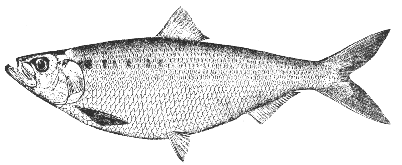Hickory shad Pomolobus mediocris (Mitchill) 1815
FALL HERRING; SHAD HERRING
[Jordan and Evermann, 1896-1900, p. 425.]

Figure 45.—Hickory shad (Pomolobus mediocris), Chesapeake Bay region specimen. From Goode. Drawing by H. L. Todd.
Description—
The hickory shad differs rather noticeably from the sea herring in that the point of origin of its dorsal fin is considerably in front of the mid-length of its trunk; in its deep belly (a hickory shad 13½ in. long is about 4 in. deep but a herring of that length is only 3 in. deep); in the fact that its outline tapers toward both snout and tail in side view (fig. 41); and in that its lower jaw projects farther beyond the upper when its mouth is closed; also, by the saw-toothed edge of its belly. Also, it lacks the cluster of teeth on the roof of the mouth that is characteristic of the herring. One is more likely to confuse a hickory shad with a shad or with the alewives, which it resembles in the position of its dorsal fin, in the great depth of its body, in its saw-toothed belly and in the lack of teeth on the roof of the mouth. But it is marked off from all of these by its projecting lower jaw. There is also a small difference in outline, its head tapering more to the snout, as seen in side view (fig. 45). It has only about half as many gill rakers (19 to 21 on the lower limb of the first gill arch) as either the alewife or the blueback; and its upper jaw, reaching back only about as far as opposite the center of its eye, is shorter than that of the shad in which it reaches as far as the rear edge of the eye.
Under favorable circumstances its color, also, is characteristic, for it is faintly marked on the sides with dusky longitudinal stripes, and the tip of its snout is dusky.
Size—
This is the largest of our anadromous herrings next to the shad, growing to a length of 2 feet. A fish about 15 inches long weighs a pound, one of 18 inches, 2 pounds.
Habits—
Nothing is known of the habits of the hickory shad in the sea to differentiate it from its close relatives of the herring tribe except that it is more of a fish eater. Launce, anchovies, cunners, herring, scup, silversides, and other small fish, squid, fish eggs, and even small crabs have been found in the stomachs of hickory shad at Woods Hole, as well as sundry pelagic Crustacea. It will strike a small spinner or other artifical lure, and it gives a good fight when hooked. In the southern parts of its range it is described as running up fresh streams, with the alewives in late winter and early spring to spawn.[64] But it appears not to do so in the streams tributary to Chesapeake Bay, though it is found in practically all of them. This opens the interesting possibility that the "green" fish found in Chesapeake Bay, leave the Bay, perhaps to spawn in salt water.[65]
General range—
Atlantic coast of North America from the Bay of Fundy to Florida.
Occurrence in the Gulf of Maine—
The hickory shad is a southern fish, with the Gulf of Maine as the extreme northern limit to its range. It is recorded in scientific literature only at North Truro; at Provincetown; at Brewster; in Boston Harbor; off Portland; in Casco Bay; and from the mouth of the Bay of Fundy (Huntsman doubts this record), and it usually is so uncommon within our limits that we have seen none in the Gulf ourselves. But in 1932 anglers, trolling for striped bass and mackerel off the Merrimac River, met a run of hickory shad.[66]
It is much more plentiful west of Cape Cod, being common from spring throughout summer and early autumn at Woods Hole, where as many as 3,500 have been taken at a single lift of one trap. In 1919 the Massachusetts catch of hickory shad, practically all from the south coast, amounted to 12,800 pounds, and none are listed for Massachusetts for any subsequent year.
[64] Smith (N. C. Geol. Econ. Surv; vol. 2, 1897, p. 121) describes it as doing so in the streams tributary to Pamlico Sound, N. C., where it is plentiful.
[65] Hildebrand and Schroeder, Bull., U. S. Bur. Fish., vol. 43, 1928, p. 84.
[66] The Museum of Comparative Zoology received one from this run from Dr. J. C. Phillips, caught by him off the northern end of Plum Island, October 2, 1932.